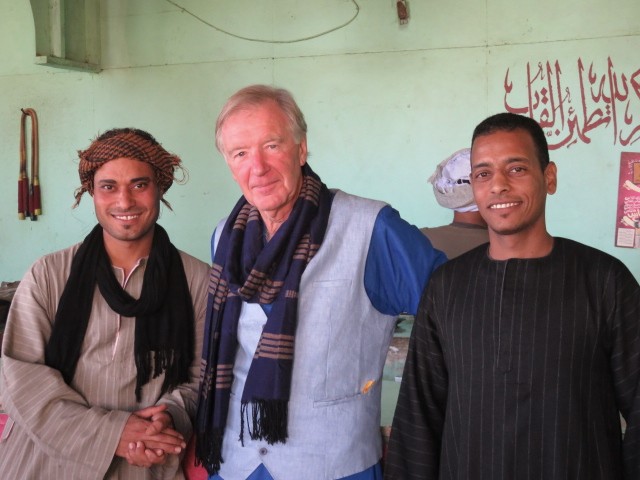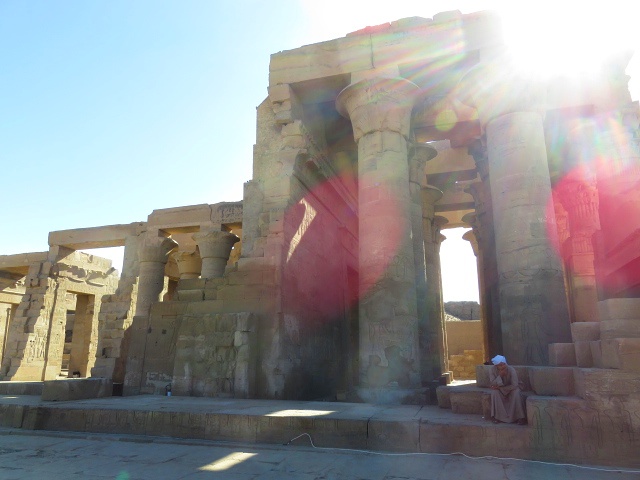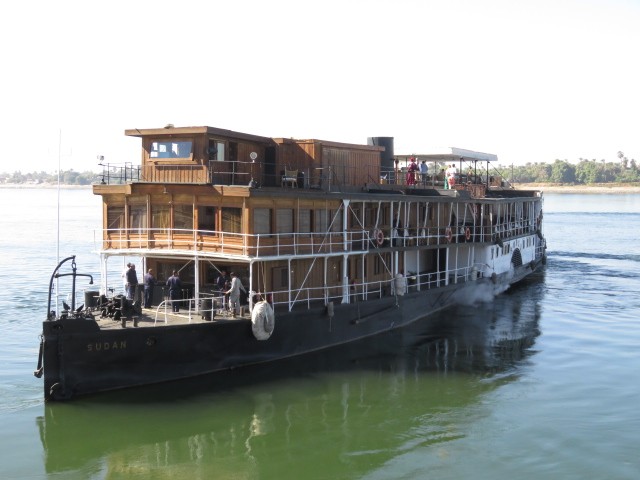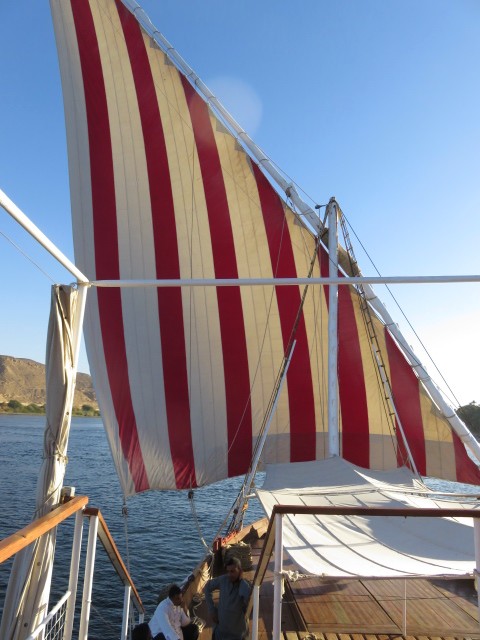It is winter in Egypt and we have taken advantage of the coolest time of year to indulge ourselves in a Nile cruise. Dozens of boats ply the route between Luxor and Aswan. Mostly they are diesel powered cruise ships - river boat behemoths like floating hotels. Then there are dahabiyas - if you want slow travel or to channel your inner Cleopatra (or Marc Antony perhaps) then a dahabiya is for you. More Agatha Christie and Hercule Poirot than Cleo and her lover, David and I have splashed out on a Nile cruise on the Meroe, a dahabiya operated by Nour el Nil.
Cruising the Nile with Nour-el-Nil
What is a dahabiya?
A dahabiya is an Egyptian sail boat with two masts. It relies on wind power. On calm days dahabiyas are pulled along by tugboats. For a full description of the dahabiya on which we sailed together with a list of the pros and cons of choosing a dahabiya cruise over a conventional Nile cruise ship see my post on - Cruising the Nile on a Dahabiya: slow travel in Egypt
 |
| The upper deck of the Meroe |
Day 1: Embarkation, the Temple of Khnum and an evening village walk
We are collected from our hotel on the east bank of Luxor at 9 a.m. Our fellow guests are coming from hotels on the west bank and are collected separately. It takes about an hour and a half to drive to Esna where our cruise departs from. Unlike diesel powered cruise boats our dahabiya doesn't go through the Esna Lock and therefore cannot leave from Luxor.
I am grateful we have the transfer car to ourselves - just me, David, the driver and a Nour el Nil guide - because we start with a panic. See last week's post on - What do you mean you left your passport on the plane! - for the story. Disaster averted we arrive in Esna where we stop by the Meroe, our dahabiya, to drop our bags and meet our fellow passengers before heading off for a tour of the Temple of Khnum.
Surrounded by urban chaos, the most striking feature of the temple is its position below ground level. Centuries of Nile floods built up soil and sediment around the temple until today it stands some 9 metres (almost 30 feet) below the surrounding streets. We have the temple to ourselves, just our small group and a team of workers perched high up on a scaffold painstakingly restoring the ancient reliefs.
A relief is a technique where a sculpture is carved from a wall or ceiling giving the impression that it is raised above the surrounding background. Reliefs are ubiquitous in the tombs and temples of Egypt. Many were once brightly painted. Today most, but not all, have lost their colour. There is a line on one wall of the temple, one side of which has been restored by careful cleaning and the other has not. I realise the colour is not so much lost, as hidden beneath centuries of built up dirt and grime.
 |
| Although this isn't the best photo I have ever taken it does show how far below ground level the temple is. |
 |
| Can you see the line where the restorers are up to? |
On the way back to the dahabiya we stroll through a market with more than the usual collection of exotic sights. The weirdest is a petrified crocodile set above a doorway. These prehistoric looking reptiles once inhabited the waters of the Nile and still do south of the dam at Aswan. Later in the cruise we will have the chance to swim in the Nile - I make a mental note to think carefully before I take part.
 |
| It is hard to know what to say about this. Would you put it above your front door? |
Just before midday we set sail for our first leisurely few hours. Lunch is a communal affair on the open top deck where we will spend our days. Although the dahabiya can accommodate twenty guests, there are only ten of us - eight adults and two children. By the beginning of our third day a medical emergency has seen our numbers dwindle to six adults and two children.
We spend the afternoon watching the banks of the Nile drift by. About 4 pm we tie up for the evening and join some of the crew for a walk to a local village where we are offered afternoon tea. Our first visit to Egypt in 2006 ended disastrously after David came down with food poisoning. You can read about it in my blog post - Our Great Cairo Catastrophe. With the memory still seared into my bones I am determined not to eat or drink anything I cannot be absolutely sure of. This determination melts rapidly in the face of such welcoming locals and I accept both the tea and pastries. I draw the line at trying a shisha pipe, although one of our fellow guests, an otherwise non-smoker, risks the purity of his lungs. He declares it fairly ordinary.
Day 2: The Tombs of El Kab and the Temple of Horus in Edfu
I wake early to the sound of the Nile lapping against the boat. Our cabin is so close to water level that with the window open I can almost reach down and touch the Nile. Even David, who is notoriously allergic to mornings, can see the point of being up early today. Being first on deck for breakfast we have the world to ourselves - an opportunity to catch those magical 'first ray's of sun' photos.
 |
| Morning on the Nile |
El- Kab
After breakfast we visit the Tombs of El-Kab. This is our first chance to see tombs which the passengers on larger cruise ships cannot. Being so much smaller, a dahabiya can pull in to places inaccessible to ordinary Nile Cruise ships. On our short walk to the tombs we pass the site of the ancient settlement of Nekhab. The massive surrounding stone walls are still intact but there seems to be little other evidence of what was one of the oldest settlements in Upper Egypt.∗
∗Upper Egypt consists of the Nile River Valley, from Cairo south to Aswan and Lake Nasser.
The tombs of El Kab are those of nobles rather than pharaohs - mayors, priests soldiers and a provincial governor. What they lack in size and grandeur they make up for in colour and the kind of everyday detail we mere mortals can relate to. There are scenes of daily life - funeral processions, feasts, fishing and agriculture. There is even a far more recent inscription of graffiti carved, according to its dates, in 1813 and 1817. At what point in history did this become a relic rather than vandalism I wonder.
 |
| Some of our group walking toward the Tombs of El-Kab - You can see the opening for one of the tombs to the left of the top of the steps. |
 |
| Inside one of the tombs |
The Temple of Horus at Edfu
Horus, the falcon headed god is, perhaps in part thanks to the movie 'Gods of Egypt', one of the best known Egyptian gods. Horus was the posthumous son of Osiris who was murdered by Seth, Horus's uncle. Horus spent many years in conflict with Seth, attempting to avenge his father's death. There are various different versions of the story none of which match up with Hollywood's colourful adaptation.
Whatever the truth of the myth, the Temple of Horus at Edfu is magnificent. One of the best preserved ancient monuments in Egypt, it is a highlight of our cruise. It is accessible by larger ships and therefore can be crowded. Nour el Nil solve the problem by calling in late in the day. The ten minute ride to the temple is by horse and carriage - or in our case a tuk-tuk. David is highly allergic to horses but the tuk-tuk is every bit as much fun. Once there, and having run the gauntlet of the inevitable souvenir sellers, we have the temple almost to ourselves.
 |
| The Temple of Horus |
 |
| Inside the Temple of Horus |
Day 3: A swim in the Nile, a walk through the desert and a Nubian village
I am indulging in a bit of poetic licence here. Neither David nor I actually brave the Nile swim. David isn't much of a swimmer at the best of times and, to be honest, although the water looks beautiful I think the risk of catching some unidentifiable, exotic disease to which locals but not tourists might be immune, is too great.
The risk of catching the dreaded lurgy, or worse - discovering Nile crocodiles are not extinct above the Aswan Dam after all - fails to deter our fellow guests. All six take the plunge and seem to enjoy themselves. Our remaining two guests have by now left the dahabiya to seek medical attention for - you guessed it - some unidentifiable, exotic disease.
 |
| The island where we tie up for a swim. It can hardly be more idyllic. |
A walk through the desert and a Nubian village
The Nubian people, whose history goes back thousands of years, live along the Nile in southern Egypt and northern Sudan. They have their own distinct culture and languages. Late in the afternoon we pull in to the banks of the Nile once more and disembark for a walk through a Nubian village. We soon collect a rag tag entourage of children, dancing around us laughing and holding out their hands in the hope of gifts. The crowd thins out as we emerge on the far side of the village into the desert. Treeless and barren it is all stones and rocks and endless stretches of sand. There is a quiet beauty to it, especially as evening approaches. Just at the point where we have had our fill of walking we see the Meroe. She has relocated during our excursion and is tied up for the night at the Temple of Horemheb.
 |
| David, with crew member Mohammed and Jean-Pierre, our cruise director, leading the way into the desert. |
 |
| We came across lots of these in Egypt. I am going to let you guess what it is. It took us ages to figure it out. |
Day 4: The Temple of Horemheb at Gebel Silsileh
Gebel Silsileh is another area inaccessible to large Nile cruise ships. There is a row of tombs, the temple and the remains of a quarry where we learn how Ancient Egyptians cut and transported the stone for their monuments. Although the site is compact, there is magic in knowing we far are from the well-known and crowded tourist sites.
 |
| Carvings at Gebel Silsileh |
In the late morning we follow our crew on another long walk while the dahabiya relocates to pick us up at a village further up river. We stop for a while at a Nubian coffee shop before continuing our journey toward Aswan.
 |
| A Nubian coffee shop |
 |
| Members of our crew. Jean-Pierre, the cruise director, is in the middle |
 |
| Inside the Nubian coffee shop. Notice the lack of women. This is not a place I would feel comfortable entering on my own. |
Day 5: The Temple of Kom Ombo and arriving at Aswan
Back in 2006 when we cruised the Nile on a large Nile cruise ship, the Oberoi Shehrazad, the most magical part of the trip was our visit to the Temple of Kom Ombo. Perhaps we got lucky because I remember we had the temple to ourselves. Kom Ombo sits close to the bank of the river. We walked off the ship, climbed a set of steps and we were there, alone except for our own little group.* It was pure Agatha Christie's 'Death on the Nile' - before the murders.
Does anyone remember my post on Longwood Gardens and why you shouldn't go back to places! I should have taken my own advice, or at the very least put a lid on my expectations. The paving stones at the entrance to the temple are being relaid. Once inside the magic is still there but picking our way through workmen, construction barriers and all the other paraphernalia of a building site takes a lot away from the atmosphere.
*Note: By pure chance, in 2006, we were on a ship with only a few other passengers. You can read why under the heading 'What are the differences between a dahabiya Nile cruise and an ordinary Nile cruise' in my post Cruising the Nile on a dahabiya: slow travel in Egypt)
The Crocodile Museum at Kom Ombo
Kom Ombo is dedicated in part to the crocodile god, Sobek. Fittingly there is a Nile crocodile museum near the temple. One look at these gigantic mummified monsters and I am confident my decision not to swim in the Nile was the right one.
The Sudan and Death on the Nile
Did I tell you to watch Agatha Christie's 'Death on the Nile' before you go to Egypt? While the film plays around with geography a little it is a great introduction to places you will visit in Luxor, Aswan and along the Nile. In 1933 Agatha Christie found the inspiration for her famous novel while cruising on the 'Sudan'. The ship was used for filming in both the 1978 and the 2004 versions of the film - or so we are told. There seems to be some question about the accuracy of this when I hit the internet back home. In any event, we are treated to the sight of the Sudan pulling in to the Temple of Kom Ombo as we pull away. I am briefly jealous of her passengers until I discover the language of the ship is French. I have no desire to resurrect my awful high school French.
Arriving at Aswan
We arrive in Aswan as the sun is setting. For once the large cruise ships have an advantage. When we docked in 2006 in the Sherhazad we were close enough to central Aswan to go for an evening stroll along the waterfront. This time our dahabiya docks too far away for a stroll. It hardly matters, David and I have three nights to look forward to at the Old Cataract Hotel, another Agatha Christie hang out, so we will have time enough to explore the city.
Save this for later. Pin it to Pinterest
Does anyone remember my post on Longwood Gardens and why you shouldn't go back to places! I should have taken my own advice, or at the very least put a lid on my expectations. The paving stones at the entrance to the temple are being relaid. Once inside the magic is still there but picking our way through workmen, construction barriers and all the other paraphernalia of a building site takes a lot away from the atmosphere.
*Note: By pure chance, in 2006, we were on a ship with only a few other passengers. You can read why under the heading 'What are the differences between a dahabiya Nile cruise and an ordinary Nile cruise' in my post Cruising the Nile on a dahabiya: slow travel in Egypt)
 |
| Relief carvings at Kom Ombo. Notice how they stand out from the background wall. |
 |
| Kom Ombo in the morning light |
The Crocodile Museum at Kom Ombo
Kom Ombo is dedicated in part to the crocodile god, Sobek. Fittingly there is a Nile crocodile museum near the temple. One look at these gigantic mummified monsters and I am confident my decision not to swim in the Nile was the right one.
The Sudan and Death on the Nile
Did I tell you to watch Agatha Christie's 'Death on the Nile' before you go to Egypt? While the film plays around with geography a little it is a great introduction to places you will visit in Luxor, Aswan and along the Nile. In 1933 Agatha Christie found the inspiration for her famous novel while cruising on the 'Sudan'. The ship was used for filming in both the 1978 and the 2004 versions of the film - or so we are told. There seems to be some question about the accuracy of this when I hit the internet back home. In any event, we are treated to the sight of the Sudan pulling in to the Temple of Kom Ombo as we pull away. I am briefly jealous of her passengers until I discover the language of the ship is French. I have no desire to resurrect my awful high school French.
 |
| The Sudan |
Arriving at Aswan
We arrive in Aswan as the sun is setting. For once the large cruise ships have an advantage. When we docked in 2006 in the Sherhazad we were close enough to central Aswan to go for an evening stroll along the waterfront. This time our dahabiya docks too far away for a stroll. It hardly matters, David and I have three nights to look forward to at the Old Cataract Hotel, another Agatha Christie hang out, so we will have time enough to explore the city.
 |
| Under sail on our last full day. |
 |
| Me on our last full day. |
Save this for later. Pin it to Pinterest



Wow. What great experiences you had along the Nile. The buildup of sediment from the river is quite impressive (Temple of Khnum being 9m below street level.)
ReplyDeleteWe had a fantastic time. It was great to have the chance to see so many things without any crowds.
DeleteGreat post! We are booked for this cruise later this year. Thanks for sharing!
ReplyDeleteI am sure you will love it. If you are going in Egypt's winter then take my advice and pack a warm jacket. It got very cold on the river at night, especially on evenings when there was a bit of wind. Did you read my earlier post on the cruise - https://www.thetravellinglindfields.com/2019/03/dahabiya-nile-cruise.html
DeleteHow exciting. I'm a fan of small ship cruising, especially when you get to visit places that the large ships can't visit. This sounds like a great adventure, though I think I would have opted out of the swimming too. #WeekendWanderlust
ReplyDeleteDavid (hubby) will only do small ship cruising. He hates crowds and being stuck on a cruise ship with thousands of other people is his idea of the 7th level of hell. Interesting you would also opt out of the swim. I was amazed that everyone else took the plunge, then I read another bloggers review from an earlier cruise and she said almost no-one on her cruise went swimming.
DeleteWhat an adventure! an absolutely fascinating trip I would love to do one day, it’s on our list. I was captivated by the Egyptian exhibit recently in New York’s Met, but I would love to see it all in situ. Thanks for sharing #weekendwanderlust
ReplyDeleteI remember the Egyptian exhibit from a visit to New York a few years ago when it was too cold to do anything other than hang around museums and shops. It is one of the best exhibits I have seen on Egypt but it did seem somehow out of place. There is nothing to compare with seeing antiquities on site where they were discovered.
DeleteWhat a cool adventure. I would love to do a cruise like this. And your morning on the Nile photo is mesmerizing!
ReplyDeleteI managed to do the whole holiday with my camera on the wrong setting - oooppps! But most of the photos survived my blunder okay.
DeleteA great post. I would to visit Egypt, sail along the Nile, visit temples and also the pyramids. My only concern about visiting Egypt is the level of safety for tourists. It seems by your post that you did not experience any risks? Thanks for sharing all your great content & inspiring me to put Egypt back on the bucket list #whatsonwatsons
ReplyDeleteWe felt absolutely safe the whole time. However only a week after we left Cairo there was a bomb attack on a group of tourists going to the Sound and Light Show at the pyramids. Several were killed. Sadly, I don't think Egypt is safe yet.
DeleteWhat an absolutely amazing adventure. We will definitely add cruising the Nile on our wish list. All of the land tours you show look so fascinating.
ReplyDeleteWe loved Egypt. It is a fabulous place to visit.
DeleteWhat an amazing trip you had - and thanks so much for sharing these photos.
ReplyDeleteMy pleasure.
DeleteThat is one cruise that would interest me, wonderful pictures, you obviously had an amazing trip.
ReplyDeleteWe had a fabulous time. Everyone should visit Egypt (if they can) at least once in their lives.
DeleteIt sounds like there is a lot of boat traffic as you describe the Nile. OMG - you left your passport on the plane! :( We also prefer the small cruise boats, so this sounds like a good option. As a water lover, I would have found it difficult to resit a swim, but I agree with your reasoning. After the swim, were all the guests sick and you and David the only ones left on the boat? Sounds like a great trip!
ReplyDeleteNo one got sick! To be fair, I have a heart condition so I have to be a bit more careful than most. If I do get sick while travelling it is potentially more serious than for most people. I didn't mention it in the post because I don't like to make a big deal out of it. It isn't a huge problem as long as I am sensible and carry enough heart drugs to make sure I never, ever, ever run out. I was diagnosed about a year after we went cycling with you and Tom in Sydney. I love the water too but sometimes it just pays to be sensible and this was one of those times for me.
DeleteMaybe no one got sick however swimming in the Nile is extremely risky.In an article printed in the Egyptian Gazette a few years ago it stated that 20 million Egyptians have Bilharzia which can kill.
DeleteI just googled Bilharzia and I am very glad now that I gave the swim the miss.
DeleteWe are loving your tales as we so loved our travels in Egypt and hope to return in the near future. We also stayed at the Old Cataract Hotel - an incredible experience in itself. I could have spent an entire day and evening just soaking in the history and ambiance of that place!
ReplyDeleteThe Old Cataract was wonderful. Sadly, I believe it loses money and if it were not owned by the government would probably not survive.
Delete